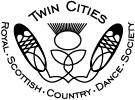The following article by Linda Mae Dennis is reprinted with permission from The Scottish Country Dancer (publication of the RSCDS Southwest Washington State Branch), vol. 29, #6. Good food for thought and helpful tips as we move into our performance repertoire rehearsal season.
There was a bit of a buzz on the Strathspey Server in December about communication on the dance floor. Many good points were made. The main one was that help given on the dance floor needs to be non-verbal. That certainly gave me something to think about, as I am very guilty of talking both to my partner and others in the set during dances. The audio channel should be reserved, most importantly for the music, and also for the teacher, coaching rhythmically as needed. And as needed is quite key.
It was noted that if help is given constantly, the people who need the help never learn to actually dance for themselves. One comment was, “This is what Hugh Foss called ‘learning to dance the way a tennis ball learns to play tennis.'” It was suggested that even non-verbal help should be limited. In fact, I was talking with a dancer just last evening who learned Scottish Country Dancing as the only beginner in a group of experienced dancers. He told me he didn’t really learn anything for a very long time, because people would show him or shove him constantly. He was never allowed to make the mental connections that lead to good dancing.
Bruce Hamilton said, “The reverse of obtrusive helping can create a virtuous circle. If help is given only when needed, and then lightly, the less experienced dancers watch more closely for the cues. That is, they pay careful attention to the faces and bodies of the people they’re dancing with (who pay careful attention to them, trying to discern whether they need help). When that becomes commonplace, the cues can become even more subtle. The dancing gets more and more musical, the dancers pay exquisite attention to each other, the touching becomes as much ‘listen’ as ‘talk’ and the whole thing just takes off.” I think this is a good goal to give only non-verbal cues and give those subtly and only when really necessary. So here are some suggestions for those who may need help and for those who wish to help:
Need Help:
Watch your partner very closely, particularly their eyes, hands, even their fingers. Keep in mind that you will almost always be either mirroring your partner or going the same way they are going, so even if you’re facing out of the set, turn your head to see what your partner is doing. Keep an eye on the faces of other dancers in your set. If their eyes move in the same direction as a tilt of their head, that’s probably the way you’re supposed to go.
Try your best to learn the lingo and try to remember the dance in manageable chunks, for example, Cross and Cast and Half Figure of Eight (one chunk) is easier to remember than Cross with Right Hands. Cast off One Place and Dance a Half Figure of Eight (3 chunks, but exactly the same thing.)
Wish to Help:
Be sure you are remembering the dance correctly before offering help, and dance well, with good handing and phrasing. This is often more helpful than just getting the figures right. Watch your partner very closely, particularly their eyes. If the eyes say ” I know what’ s next!” then enjoy the music and the dancing and let your partner do the same. Try to give hands on the phrase (not before). Try to make any helping gestures more and more subtle as you progress through the dance.
We all need to keep in mind that making mistakes is part of dancing, and that a good mistake enhances the enjoyment of the dancing better than any amount of shouting or shoving or even loud talking and wild gestures ever will. Mum’s the word!
